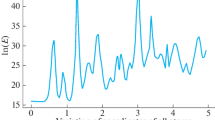Abstract
A global optimization algorithm is proposed for finding the global minimum potential energy conformations of small molecules. The minimization of the total potential energy is formulated on an independent set of internal coordinates involving only torsion (dihedral) angles. Analytical expressions for the Euclidean distances between non-bonded atoms, which are required for evaluating the individual pairwise potential terms, are obtained as functions of bond lengths, covalent bond angles, and torsion angles. A novel procedure for deriving convex lower bounding functions for the total potential energy function is also introduced. These underestimating functions satisfy a number of important theoretical properties. A global optimization algorithm is then proposed based on an efficient partitioning strategy which is guaranteed to attain ε-convergence to the global minimum potential energy configuration of a molecule through the solution of a series of nonlinear convex optimization problems. Moreover, lower and upper bounds on the total finite number of required iterations are also provided. Finally, this global optimization approach is illustrated with a number of example problems.
Similar content being viewed by others
References
N.L. Allinger,Adv. Phys. Org. Chem.,13, 1, (1976).
N.L. Allinger, M.A. Miller, F.A. Van Catledge, and J.A. Hirsch, Conformational Analysis. LVII. The Calculation of the Conformational Structures of Hydrocarbons by the Westheimer-Hendrickson-Wiberg Method,J. Am. Chem. Soc,89, 4345, (1967).
U. Burkert and N.L. Allinger,Molecular Mechanics, (American Chemical Society, Washington, D.C.1982).
W.A. Coppel,Stability and Asymptotic Behavior of Differential Equations, (Boston, Mass.: D.C. Heath, 1965).
T.H. Cormen, C.E. Leiserson, and R.L. Rivest,Introduction to Algorithms, (McGraw-Hill Book Company, 1989).
G. Dalquist, Stability and Error Bounds in the Integration of Ordinary Differential Equations,Trans. Roy. Inst. Tech.,130, (1959).
P. de la Mare, L. Fowden, E.D. Hughes, and C.K. Ingold,J. Chem. Soc, 3200, (1955).
C.A. Desoer and H. Haneda, The Measure of a Matrix as a Tool to Analyze Computer Algorithms for Circuit Analysis,IEEE Trans. Circ. Th.,19, 480, (1972).
I. Dostrovsky, E.D. Hughes, and C.K. Ingold,J. Chem. Soc, 173, (1946).
C.A. Floudas and V. Visweswaran, A Global Optimization Algorithm for Certain Classes of Nonconvex NLPs, Part 1: Theory,Computers and Chemical Engineering,14, 1397, (1990).
C.A. Floudas and V. Visweswaran, Primal-Relaxed Dual Global Optimization Approach,Journal of Optimization Theory and its Applications,78, Iss. 2, 187, (1993).
M.R. Garey and D.S. Johnson,Computers and Intractability: A Guide to the Theory of NP-Completeness, (Freeman, San Francisco, 1979).
T.L. Hill,J. Chem. Phys,14, 465, (1945).
A.J. Hopfinger,Conformational Properties of Macromolecules, (Academic Press, New York and London, 1973).
R. Horst and H. Tuy,Global Optimization, Deterministic Approaches, (Springer-Verlag, Berlin 1990).
E.J. Jacob, H.B. Thompson, and L.S. Bartell,J. Chem. Phys.,49, 2574, (1968).
A.C. Kokossis and C.A. Floudas, Stability Issues in Optimal Design: Synthesis of Comples Reactor Networks,AIChE, in press, (1994).
D.G. Luenberger,Linear and Nonlinear Programming, (Addison-Wesley, Reading, Mass., 1984).
C.D. Maranas and C.A. Floudas, A Global Optimization Approach for Lennard-Jones Microclusters,J. Chem. Phys.,97, 10, (1992).
C.D. Maranas and C.A. Floudas, Global Optimization for Molecular Conformation Problems,Annals of Operation Research, in press, (1993).
B.A. Murtagh and M.A. Saunders,MINOS 5.3 User's Guide, (Systems Optimization Laboratory, Department of Operations Research, Stanford University, 1987).
A.T. Phillips and J.B. Rosen, A Parallel Algorithm for Constrained Concave Quadratic Global MinimizationMath. Prog.,42, 421, (1988).
L. Piela, J. Kostrowicki and H.A. Scheraga, The multiple-Minima Problem in the Conformational Analysis of Molecules. Deformation of the Potential Energy Hypersurface by the Diffusion Equation Method,J. Phys. Chem.,93, 3339, (1989).
M. Rieger and F.H. Westeheimer,J. Am. Chem. Soc.,72, 19, (1950).
Z. Slanina, Does the Global Energy Minimum Always Also Mean the Thermodynamically Most Stable Structure?,J. Mol. Str.,206, 143, (1990).
R. Susnow, R.B. Nachbar, C. Schutt, and H. Rabitz, Sensitivity of Molecular Structure to Intramolecular Potentials,J. Phys. Chem.,95, 8585, (1991).
H.B. Thompson, Calculation of Cartesian Coordinates and Their Derivatives from Internal Molecular Coordinates,J. Chem. Phys.,47, 3407, (1969).
J.M. Troyer and F.E. Cohen,Simplified Models for Understanding and Predicting Protein Structure, VCH Publishers, New York, NY, 1991.
B. van der Graaf and J.M.A. Baas, The Implementation of Constraints in Molecular Mechanics to Explore Potential Energy Surfaces,Rev. Trav. Chim. Pays-Bas,99, 327, (1980).
V. Visweswaran and C.A. Floudas, A Global Optimization Algorithm (GOA) for Certain Classes of Nonconvex NLPs, Part 2: Applications of Theory and Test Problems,Computers and Chemical Engineering,14, 1419, (1990).
V. Visweswaran and C.A. Floudas, A Global Optimization Algorithm (GOA) for Certain Classes of Nonconvex NLPs, III. New Properties for Improved Computational Performances,Proceedings of Process Systems Engineering, PSE '91, 1.6.1, (1991).
V. Visweswaran and C.A.Floudas, New Properties and Computational Improvement of the GOA Algorithm for Problems with Quadratic Objective Function and Constraints,Journal of Global Optimization,3, Iss. 2, in press, (1993).
A. Warshel and S.J. Lifson, Consistent Force Field Calculations. II Crystal Structures, Sublimation Energies, Molecular and Lattice Vibrations, Molecular Conformations, and Enthalpies of Alkanes,J. Chem. Phys.,53, 582, (1970).
F.H. Westeheimer and J.E. Mayer,J. Chem. Phys.,14, 733, (1946).
J.E. Williams, P.J. Stang, P. Schleyer, Physical Organic Chemistry: Quantitative Conformational Analysis; Calculation Methods,Ann. Rev. Phys. Chem.,19, 531, (1968).
Author information
Authors and Affiliations
Rights and permissions
About this article
Cite this article
Maranas, C.D., Floudas, C.A. Global minimum potential energy conformations of small molecules. J Glob Optim 4, 135–170 (1994). https://doi.org/10.1007/BF01096720
Issue Date:
DOI: https://doi.org/10.1007/BF01096720




